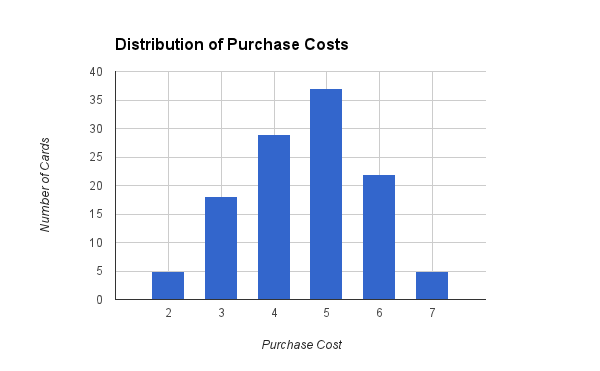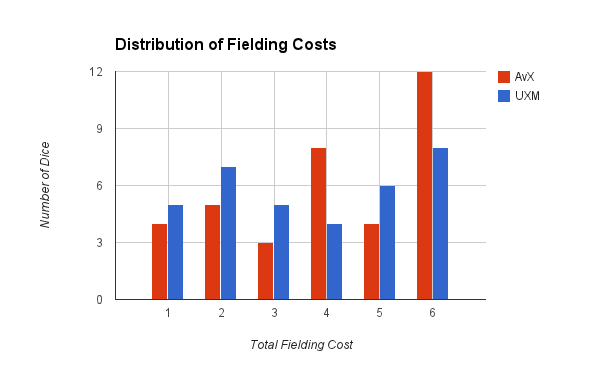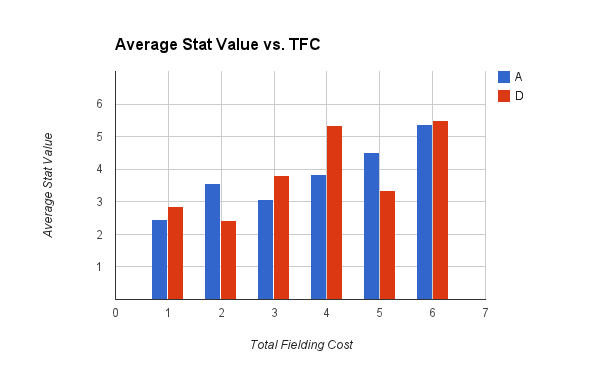 Much as it took a bunch of number-wrangling and spreadsheet-poking, I really enjoyed that time I went and took a look at how the purchase costs/character stats for AvX stacked up, and what that meant for the game at the time. I'd been anticipating doing the same thing for UXM, but assumed I'd need to wait till post-release, when we'd have all the cards compiled, to do so. With all the spoilers on Facebook and at cons, we'd seen most of the set, but I wanted everything for my little numbers dance, so I wasn't quite ready.
Much as it took a bunch of number-wrangling and spreadsheet-poking, I really enjoyed that time I went and took a look at how the purchase costs/character stats for AvX stacked up, and what that meant for the game at the time. I'd been anticipating doing the same thing for UXM, but assumed I'd need to wait till post-release, when we'd have all the cards compiled, to do so. With all the spoilers on Facebook and at cons, we'd seen most of the set, but I wanted everything for my little numbers dance, so I wasn't quite ready.And then, Mathew from Diceanon.com contacted me; between cards he'd picked up and what had been put out, he'd put together a full card spoiler for the set. Armed with that, I was ready to begin figuring out how USM measured up in the world of purchase and fielding cost curves, power fluctuations, and so on.
Guess what? My findings are nowhere near as dire as last time!
The Purchase Costs Form A Roughly Bell-Shaped Curve!
Our average-of-averages tells us that the average purchase cost for UXM is 4.59; 4.58 if you count Cerebro. This tells us that the average card will be a four or (slightly more likely) a five, which absolutely fits what we see above. We'll see if the average played card winds up costing four or five, though from my proto-villain deck (which, given the full card list, needs some reworking - look for an article on that up next!), it seems like a decent prospect.
Also notable is that there are exactly five two-cost cards in the set; three of these have no abilities. This paints a clear message: two cost characters are for using for quick, no-frills fighters, or for energy. That, plus a rise in 'midrange' purchase cost characters - particularly five-costs, who cannot simply be bought with your opening bag of sidekicks - suggests what has been floating around for a while: there's an intent to have a progression during a game. Clearly, we should start with a few cheaper characters to hold down the fort, use them to block and such while we get some midrange characters, and then discard the cheap guys to use as energy to field those midranges and buy some endgame 6/7s to seal the deal.
This isn't to say you can't run a weenie rush squad; honestly, I think that'll still be a valid choice, as there are several good, cheap characters. By stepping back on both the number and the power level of the cheapest cards, though, they're clearly stating they don't want it to be the ONLY option. I'm down with that; while I'm clearly enamored with my villain deck, I don't expect, and wouldn't want it to be the only tournament-viable squad around. Promoting variety is great, and means more interesting games for everyone - and that's what we're playing MDM for, right?
Looking at purchase costs by energy type, Shield inches upwards from AvX's 4.76 to a 4.92; not a surprise, considering that it lacks any cheap character other than Angel. Bolt stays virtually the same with a 4.79 (it's up about .005, for people who care); it also lost out on the two-cost train, but has fewer 'big guys' with 6+ costs than Shield, and more 4-cost cards overall. Fist sheds half a point of average purchase cost from AvX, going from a 4.98 to a 4.55; this was accomplished by having two cheap characters (Falcon and Ant Man) and keeping most of the rest to a 4-4-5 cost. Mask is the big winner (or is that weenie-er?), though, plunging from 4.81 to 4.09. Hogging all the cheap characters will do that.
The Fielding Costs Are Flatter!
So, first off - the average fielding cost in UXM is about 3.66. That's almost half an energy less than AvX - fairly significant, I'd say. But where, exactly, are our savings coming from? Do we have lots of cheap dice? Very few expensive dice? The answer is yes, to both...sort of.
As we can see, TFC 6 is still the most common grouping. We still have a good number of expensive dice - though I'll note, fully four of them (Magneto, Professor X, Red Hulk, Wolverine) are rehashes, so we really only have four new TFC 6 characters. Really, though, the difference is in proportion - the most common only beats out the least by a 2:1 factor, and most of the other categories are a lot closer. Compare the two sets:
AvX (the red) has a low baseline, with around 4 dice in four of six buckets, and big spikes in the other two camps. Every TFC value in UXM (blue) is somewhere in the 4-8 dice range, and we actually wind up with an average of slightly under 6 dice per bucket here. So while there's more of some TFCs than others, it's not grossly more, and everything's a lot more balanced, TFC-wise, than it was before.
Again, I think what we're seeing is what I alluded to in the last stat hoedown, and lots of people have stated all over the place - the idea that we should be using a base of cheaper characters to go and purchase/field our chosen big guys. The problem from a fielding cost standpoint before was that there was a relative drought of cheap options compared to a glut of expensives, making it hard to put that into practice (working with, of course, the presence of some very, very good cheap options that made it superfluous to use the big guys). This time, we're much more spoiled for choice on 'building block' characters we can get out cheap and/or use for energy when needed. I am 100% down with that; it's going to mean more squad variation and keep people on their toes more, and it's going to give more of a sense of progression to matches, which is also good in my book.
Looking at the breakdown by flavor of energy, Shield remains the most expensive flavor of character to field with an average of 4.25 - lower than in AvX, but not by much, and almost three-quarters of a point more than average. Fists are next, at 3.90 - about a quarter point over average; it has the dubious honor of being the only energy type to be more expensive on average than in AvX. Bolt is slightly under average at 3.55; it remains a 'cheaper' flavor, but not quite as drastically as it was in AvX. Mask continues its domination of cost-effectiveness, with an average fielding cost of 2.88; clearly, Mask is the place to go for value in UXM.
Stats Are A Little More Varied!
In AvX, stats were pretty straightforward: as fielding costs increased, so did stats, and defense was usually a little higher than offense. This has changed in UXM:
I'll level with you - stats do still increase as you go up in fielding cost, which is sort of expected; it'd be weird if a cheaper class of character was better than the more expensive. That said, note that for 1/2 cost characters, on average they will have more offense then defense (if only slightly) - this points to a bunch of offensively-oriented characters mixing it up with a similar number of more 'balanced' characters to end up with a slight offensive slant. Interestingly, stat averages overall are still pretty similar to where they were in AvX; they're maybe slightly depressed in general, with offense on 1/2 characters being up, but mostly it's nothing dramatic. The notable exception to 'nothing dramatic' is that 2-cost characters are much less tanky than they used to be, on average losing a point and a half of defense - you can thank smashy fellows like Mister Sinister and overall weaker-statted characters like Toad for that.
Things get a little more interesting when we look at stat values vs. TFC, though.
Right away, we see that TFC 2 and 5 are OFFENSE TOWN. Though, realistically, this is the work of a couple of dice in each division pushing up the offense value and down the defense value, it's clear that there's a trend here. I am cool with this being a thing, after AvX's largely defense-oriented character set.
We also get our first real look at what TFC 3 looks like statwise - with only three dice in AvX, one of which was Mystique with weird stat skew, its averages were sort of meaningless there. While Mystique is back fouling up our numbers again, we can see that it's taken its place as a solid step in the stat progression. Notably, though, we're still split on the two 'flavors' of TFC 3 (0-1-2 vs. 1-1-1), so there's still no dominant mode there.
Note, though, that stats are still not varying too much from AvX. 2s and 5s gained some offense and lost some defense, but otherwise there hasn't been a lot of movement from the established categories. This could suggest that we may seem that same issue that we were talking about last time - since cheap characters have more stats for the same energy, they still wind up more efficient to use. That's certainly a possibility, and it's part of the reason that I'm not looking to discount weenie teams yet - numerically, they have better stats per energy still. That said, considering that we have weaker tools for drawing extra dice this time around, I think we're going to have to focus more on getting more power in fewer dice - we will have a harder time flooding our pools with all those weenies, so we need to consolidate more. That many of the cheaper characters also wind up with no, or weaker/situational abilities, also feels like we're being moved in that direction.
Things get a little more interesting when we look at stat values vs. TFC, though.
Right away, we see that TFC 2 and 5 are OFFENSE TOWN. Though, realistically, this is the work of a couple of dice in each division pushing up the offense value and down the defense value, it's clear that there's a trend here. I am cool with this being a thing, after AvX's largely defense-oriented character set.
We also get our first real look at what TFC 3 looks like statwise - with only three dice in AvX, one of which was Mystique with weird stat skew, its averages were sort of meaningless there. While Mystique is back fouling up our numbers again, we can see that it's taken its place as a solid step in the stat progression. Notably, though, we're still split on the two 'flavors' of TFC 3 (0-1-2 vs. 1-1-1), so there's still no dominant mode there.
Note, though, that stats are still not varying too much from AvX. 2s and 5s gained some offense and lost some defense, but otherwise there hasn't been a lot of movement from the established categories. This could suggest that we may seem that same issue that we were talking about last time - since cheap characters have more stats for the same energy, they still wind up more efficient to use. That's certainly a possibility, and it's part of the reason that I'm not looking to discount weenie teams yet - numerically, they have better stats per energy still. That said, considering that we have weaker tools for drawing extra dice this time around, I think we're going to have to focus more on getting more power in fewer dice - we will have a harder time flooding our pools with all those weenies, so we need to consolidate more. That many of the cheaper characters also wind up with no, or weaker/situational abilities, also feels like we're being moved in that direction.
Conclusion: The Dice, They Are A-Changin'
The complaints of AvX were that there were too many expensive cards/dice, and not enough cheap ones. The good news about UXM: it's made a pretty strong attempt at fixing the dice side of that equation, with much more balanced amounts of all tiers of fielding cost. Like I'd said earlier, I'm pretty psyched about that; while obviously some characters are going to show up more than others, it at least suggests that we're going to have more diversity, as players will be less forced to pick the same small group of cheap characters to get their game started. We're actually seeing even fewer cheap cards, but they're being much more explicit that cheap characters are really there to either get boots on the ground or potential energy into your bag, and that if we really want to use some cool powers, we'll need to pony up.
What this paints for us is a much clearer picture of how they expect the game to be played. We have no dirt cheap power cards that we'll be throwing out turn 3; we're going to buy useful characters with modest stats, use them (be it in combat, or for energy) to start deploying our main strategy, and then phase out older stuff as we can to buy our capstone and crush our foes. We're no longer looking at 'buy guys, crush foes with them.' The dice, they are a-changin', and the way they're changing is by promoting progression. While I've yet to have a chance to play with the new set - I'm counting the days till that isn't the case - my gut tells me that it's a good thing.
Time will tell, but I think overall, the numbers are spelling out that these changes are for the better.

.png)
.png)
.png)
.png)
.png)
.png)
I love this kind of analysis, Evan. Great work. Now I don't have to do it!
ReplyDeleteI like seeing how the stat to TFC is measured. Looks like TFC 4 is the happy number for heavy hitters. They both dish it and can take a beating.
Thanks for the shout out! Keep up the good math.
Thanks for the hard work on this, Evan. Really interesting especially when compared with the previous set. I'm very glad that this is the direction the game has taken, since it's clear that a progression in dice and powers was the intended gameflow.
ReplyDeleteThe biggest thing that concerns me about encouraging progression is the time limit they expect matches to go. I have yet to have a match that clocks in under 30 minutes. I've watched a lot of YouTube videos that run around 30 minutes as well.
DeleteProgression makes the most sense, but somewhere I read WizKids wants a typical game to last 17-20 minutes. I imagine most tournaments would be a one-and-done, not best 2 out of 3.
Thanks for sharing your exquisite analysis sir.
ReplyDeleteBrilliant analysis! I will have to read this article a few more times to really get a feel for the scope of stats provided, but there is useful information in there.
ReplyDeleteJob well done!
Now, if you'll excuse me I need an aspirin.